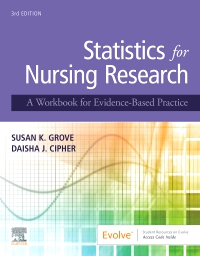
Statistics for Nursing Research – Elsevier eBook on VitalSource, 3rd Edition
Elsevier eBook on VitalSource

Help your students better understand and apply the statistical methods used in nursing and other health sciences research articles with Statistics for Nursing Research: A Workbook for Evidence-Based Practice, 3rd Edition. Perfect for both self-study and instructor-led coursework, this collection of practical exercises guides students in how to critically appraise sampling and measurement techniques, evaluate results, and conduct a power analysis for a study. Written by nursing research and statistics experts Drs. Susan K. Grove and Daisha Cipher, this is the only statistics workbook for nurses to include research examples from both nursing and the broader health sciences literature for an interprofessional perspective on evidence-based practice. This new third edition features new research articles and examples, an enhanced focused on statistical methods commonly used in DNP projects, new examples from quality improvement projects, new content on paired samples analysis, expanded coverage of calculating descriptive statistics, an online research article library, and more! Whether used in undergraduate, master’s, or doctoral education or in clinical settings, this workbook is an indispensable resource for any nursing student or practicing nurse needing to interpret or apply statistical data.
Newer Edition Available
Statistics for Nursing Research - Elsevier eBook on VitalSource
-
- Comprehensive coverage and extensive exercise practice address all common techniques of sampling, measurement, and statistical analysis that students are likely to see in nursing and health sciences literature
- Literature-based approach uses key excerpts from published studies to reinforce learning through practical application
- 36 sampling, measurement, and statistical analysis exercises provide a practical review of both basic and advanced statistical techniques
- NEW! Updated research article excerpts and examples are incorporated throughout to ensure currency and relevance to current practice
- NEW! Research Article Library on Evolve provides full-text access to key articles used in the book
- NEW! Enhanced focus on statistical methods commonly used in DNP projects and expanded coverage on calculating descriptive statistics broadens students’ exposure to the statistical methods they will encounter evidence-based practice projects and in the literature
- NEW! Examples from quality improvement projects give students a solid foundation for meaningful, high-quality evidence-based practice projects
- Study questions in each chapter help students apply concepts to an actual literature appraisal
- Questions to Be Graded sections in each chapter (with Answer Guidelines provided online for faculty) help faculty assess mastery of key statistical techniques
- NEW! Content on paired samples analysis familiarizes students with this type of research analysis
- Consistent format for all chapters enhances learning and enables quick review
-
- NEW! Updated research articles and examples are incorporated throughout to ensure currency and relevance to practice
- NEW! Enhanced focus on statistical methods commonly used in DNP projects and expanded coverage on calculating descriptive statistics broadens your exposure to the statistical methods you will encounter in evidence-based practice projects and in the literature
- NEW! Examples from quality improvement projects provide a solid foundation for meaningful, high-quality evidence-based practice projects
- NEW! Research Article Library on Evolve provides full-text access to key articles used in the book
- NEW! Content on paired samples analysis familiarizes you with this type of research analysis
- NEW! Many figures added to serveral exercises to help you understand statistical concepts
-
Part 1: Understanding Statistical Methods
1. Identifying Levels of Measurement: Nominal, Ordinal, Interval, and Ratio
2. Identifying Probability and Nonprobability Sampling Methods in Studies
3. Understanding the Sampling Section of a Research Report: Population, Sampling Criteria, Sample Size, Refusal Rate, and Attrition Rate
4. Understanding Reliability of Measurement Methods
5. Understanding Validity of Measurement Methods
6. Understanding Frequencies and Percentages
7. Interpreting Line Graphs
8. Measures of Central Tendency: Mean, Median, and Mode
9. Measures of Dispersion: Range and Standard Deviation
10. Description of a Study Sample
11. Interpreting Scatterplots
12. Algorithm for Determining the Appropriateness of Inferential Statistical Techniques
13. Understanding Pearson Product-Moment Correlation Coefficient
14. Understanding Simple Linear Regression
15. Understanding Multiple Linear Regression
16. Understanding Independent Samples t-test
17. Understanding Paired or Dependent Samples t-test
18. Understanding Analysis of Variance (ANOVA) and Post Hoc Analyses
19. Understanding Pearson Chi Square
20. Understanding Spearman Rank-Order Correlation Coefficient
21. Understanding Mann-Whitney U Test
22. Understanding Wilcoxon Signed-Rank Test
Part 2: Conducting and Interpreting Statistical Analyses
23. Selecting Appropriate Analysis Techniques for Studies
24. Describing the Elements of Power Analysis: Power, Effect Size, Alpha, and Sample Size
25. Conducting Power Analysis
26. Determining the Normality of a Distribution
27. Calculating Descriptive Statistics
28. Calculating Pearson Product-Moment Correlation Coefficient
29. Calculating Simple Linear Regression
30. Calculating Multiple Linear Regression
31. Calculating t-tests for Independent Samples
32. Calculating t-tests for Paired (Dependent) Samples
33. Calculating Analysis of Variance (ANOVA) and Post Hoc Analyses Following ANOVA
34. Calculating Sensitivity and Specificity
35. Calculating Pearson Chi-Square
36. Calculating Odds Ratio and 95% Confidence Intervals
References
Appendices
A: Critical Values for Student's t Distribution
B: Critical Values of r for Pearson Product Moment Correlation Coefficient
C: Critical Values of F for α = 0.05 and α = 0.01
D: Critical Values of the χ2 Distribution



 as described in our
as described in our 